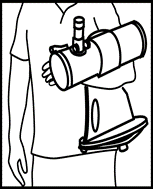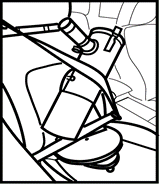FAQs - Patrons Getting Started
How to operate the telescope.
Menu
Frequently Asked Questions
1) Where would it be best to use the Library Telescope?
If you live in a light polluted area, the Moon and Planets will be visible in a library telescope. The Moon can also be viewed in the daytime.
Deep sky objects (DSOs) like galaxies, nebula, and clusters will be best viewed under a dark location. See the Astronomy League “Urban Observing” program for suggestions of items to see under light polluted skies:
https://www.astroleague.org/al/obsclubs/urban/urban.html
For more information on light pollution see DarkSky International website at https://www.darksky.org
2) What can you see with the Library Telescope?
The easiest object to see in the night sky is often the Moon. The Library Telescope will give excellent views of the Moon with surprisingly different views at different phases of the Moon and can sometimes be viewed during the daytime.
The inner planets (Mercury, Venus, Mars, Jupiter and Saturn) are easily seen when visible in your night sky. Mercury is somewhat difficult to see as it is always close to the Sun. Be sure to never point the Library Telescope at the Sun as permanent eye damage may occur. Venus and Mars can be very interesting, especially when they are close to Earth. Jupiter and Saturn are stunning through the Library Telescope. Uranus and Neptune are difficult to see under the best of circumstances.
Other things to see include stars (double stars can be spectacular). Nebula and galaxies can be visible though often appear as fuzzy spots depending on seeing conditions and surrounding light.
The constellation guide provided in most kits describes many deep sky objects. Look for objects marked with an “M”, signifying one of the 110 “Messier” objects. These are easy to look up on the web and on many planetarium apps. They are often pretty bright and fascinating things observable in binoculars or small telescopes.
The LTP scope has a very wide field of view, meaning you get to see a large part of the sky. Most beginner telescopes give views rather like looking through a straw. Start your viewing using low power (set the zoom to 24). This will allow you to find things better. Use high power sparingly, as things will be bigger, but dimmer and will leave your field of view quite fast. Some targets, like the Andromeda Galaxy (M31) or the Pleiades (M45) are surprisingly big and are best seen using a low power, as this will give you a bright, wide field of view.
3) Is training offered on how to use the Library Telescope?
Yes, videos are available on this website and also on our YouTube Channel.
- View videos offered on this website: How to Use Videos
- The Library Telescope YouTube channel at https://www.youtube.com/channel/UCBmzBNetHg4B3pzcRJNsN9g
4) How do you carry the Library Telescope?
The recommended way to carry the Library Telescope is to place the vertical support for the telescope tube in the fold of your arm and pull it to your body (the football hold) as shown in the following picture. This allows one arm to hold the telescope with the other arm free to open doors (and stiff arm oncoming defensive linebackers).

5) Why isn’t there a case to carry the Library Telescope?
With the various modifications made to the Library Telescope there are pieces that stick out from it and could be damaged if bumped into anything. Keeping all the pieces visible makes it less likely to bump any of the pieces.
Totes of various type have been tried and mostly found to be more trouble than they are worth. The “football hold” from above is secure and leaves a hand free. Telescopes in totes tend to rattle around in them, they are hard to secure in a car and need two hands to hold the rather bulky mass.
6) How do you transport the Library Telescope in a car?
The Library Telescope should be strapped into the car seat (as shown below) with the vertical support against the seatback. The lap belt should go across the bottom of the vertical support and the shoulder belt should go across the tube with the open end of the tube pointing up and into the middle of the car.


